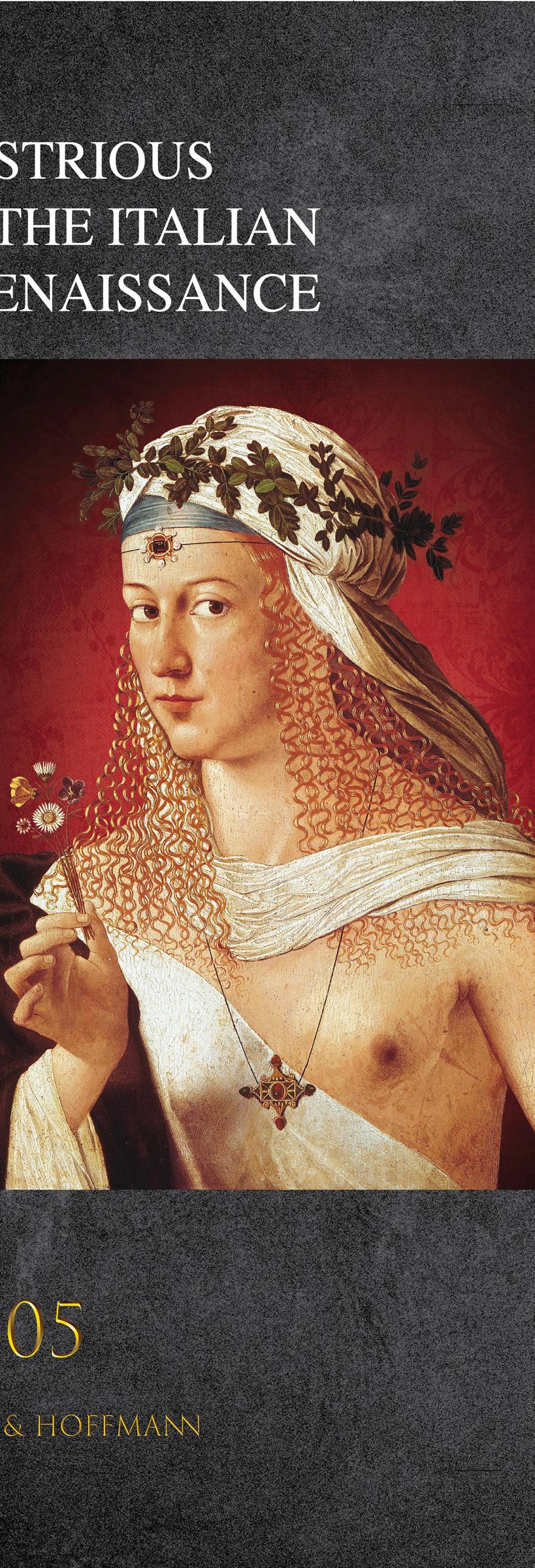
4 minute read
DAUGHTERS OF THE RENAISSANCE
By CHRISTOPHER HARE
world. The prison doors were thrown open, and in the newly awakened joy of life, the men of the Renaissance raised their eyes from contemplation of the cloister and the grave, and cried aloud in exultation,“ It is good for us to be here !“
Advertisement
Then a wonderful thing happened. At this moment of new intellectual birth, of enfranchisement from old prejudices, the beautiful dead past came back, newly revealed, to a generation eager to see, to comprehend all things. The world of classical antiquity, the beauty and strength of ancient Greece and Rome, was a revelation to the far-off sons and daughters of that heroic breed, all unconscious of their glorious heritage. A very fever of enthusiasm was aroused, not alone for the priceless treasures of sculpture in marble and bronze, found beneath the Italian soil, but also for the classics of language and literature, the works of Homer and Plato, of Aristotle and Virgil, of the philosophers and the tragedians of ancient fame. Then came the fall of Constantinople in 1453, and the ruin of the Eastern Empire brought a fresh impulse to the West, in rediscovered treasures and learned exiles.
The religious ideal of the Middle Ages had appealed alike to all—to rich and poor, to the learned and the ignorant ; but the cultured spirit of the Renaissance was almost exclusively the possession of those classes who enjoyed wealth and leisure. This mighty intellectual impulse touched women even more deeply than men, for it not only gave them a new independence, but raised them to a high position in social life and the encouragement of art. Sharing the same learned education as the men, they had perhaps in a more marked degree, the passionate love of the beautiful, and the keen desire to collect antique sculptures, paintings, musical instruments, and rare classics brought within their reach by the new wonder of the printing-press. Thus it comes to pass that in so many a brilliant Court—of Mantua, of Urbino, of Milan, of Naples, of Ferrara, of Asola, and others—we find that a cultured woman is the central figure, who gives harmony to the whole group. So, in making a special study of women in the Italian Renaissance, we find the most typical instances amongst the princesses and great ladies of the day.
Before entering upon individual studies, it will be interesting to consider the conditions of life during the whole period, and to recreate the very atmosphere of that long-past day, to us so strange and remote.
We will attempt to trace the surroundings of an Italian woman of the Renaissance, through the varied scenes of her life, beginning at the hour of her birth. Here, on the threshold, we are met with the knowledge, sharply accentuated in the case of a princess, that too often she is not welcome. Thus we read in a chronicle of Ferrara. And in the case of a little girl born to Isabella d’Este, we find that the mother would not use the splendid golden cradle with which she had been presented, but put it aside for ten years, until at length the hopedfor son arrived, and it was brought forth in state for his use. Yet although so vastly inferior to her brothers, a daughter was of some value as a counter in the game of politics.
While she was still an infant, her father would cast an anxious glance towards the neighboring Courts of Italy, or his ambition might even stretch out as far as Paris, Madrid, or Innsbruck, to consider bywhat alliance he could best strengthen his position. Then would follow long and shrewd negotiations with some prince who was fortunate enough to possess a son, and in due time, often at a very early age, the little maiden was betrothed— married by proxy to an unseen bridegroom. In this “marriage for the future” between Vittoria Colonna and Ferrante of Pescara, neither of the children was more than four years old, while in that of Beatrice d’Este, she was five, and Lodovico Sforza, Duke of Bari, was twenty-nine. When a father’s mind was thus set at rest as to the future of his little girl, he had leisure to consider her education. In some cases it was part of the bargain that the child-bride should be brought up in the household of her future husband, that she might enter upon her new life as soon as possible, before she had formed ideas of her own, and could still be molded to suit the place she had to fill. This was often quite successful, as in the case of Vittoria Colonna, who owed so much of her future distinction to the cultured training of Ferrante’s elder sister, Costanza d’Avalos, in the fair isle of Ischia.
The children were both sweet tempered and grew up happily together; indeed Vittoria’s devotion to her young husband is a theme of romance- But in other cases, the plan of bringing up together a future husband and wife has had disastrous consequences, and resulted in mutual dislike ; as with Giovanna I. of Naples and Andreas of Hungary, whose tragic story is told later on. There were other dangers, too, with regard to sending a little girl to the Court of her future husband. Sometimes a change of policy or some other cause would break the contract, and then the result was most unfortunate. For instance, Margarita, the daughter of the Emperor Maximilian, was sent to France to be educated as the wife of Charles VIII., but this young king decided to marry, for the sake of her goodly heritage, Anne de Bretagne, who was already betrothed to Maximilian, and poor Margarita was sent back to her father. The result of this cruel insult was a long and devastating war.








